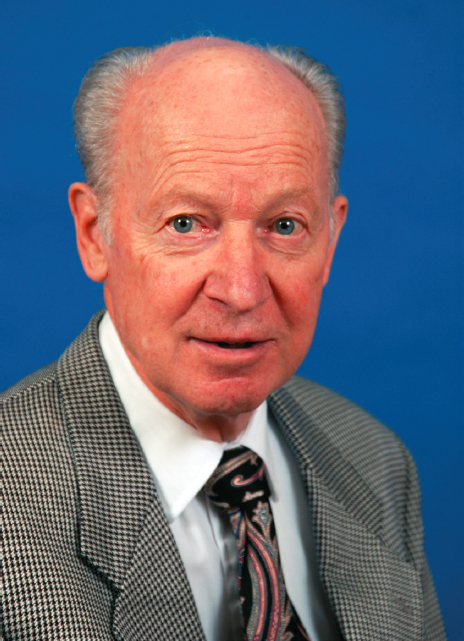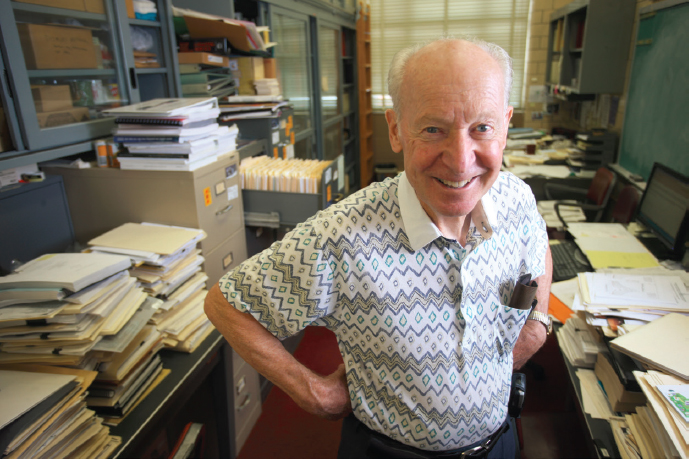KARL A. GSCHNEIDNER JR.
1930–2016
Elected in 2007
“For contributions to the science and technology of rare-earth materials.”
BY VITALIJ K. PECHARSKY
SUBMITTED BY THE NAE HOME SECRETARY
KARL ALBERT GSCHNEIDNER JR., an international authority in rare earths and former Anson Marston Distinguished Professor of Engineering at Iowa State University of Science and Technology (ISU), died April 27, 2016, at the age of 85.
He was formerly senior scientist and group leader at the US Department of Energy (DOE) Ames Laboratory, chief scientist at the Critical Materials Institute (a US DOE Energy Innovation Hub), founder and former director of the Rare Earth Information Center at Ames Laboratory, and founder and former senior editor of the Handbook on the Physics and Chemistry of Rare Earths.
Karl was born in Detroit on November 16, 1930, into a family of German immigrants who had come to the United States shortly after World War I and settled in Michigan. In 1952 he received his bachelor of science degree in chemistry, with minors in physics and mathematics, from the University of Detroit (now University of Detroit Mercy). He then moved west to continue his education at Iowa State College (now ISU) in Ames, under the supervision of Frank H. Spedding (NAS 1952) and Adrian H. Daane. He completed his thesis, entitled “The Rare Earth–Carbon Systems,” and received his PhD degree in physical chemistry, with minors in physics and metallurgy, in 1957.
While at Iowa State, Karl met Melba Pickenpaugh. They married just before his graduation and spent their honeymoon in Texas (Big Bend) and then went west to move to the Los Alamos Scientific Laboratory (now Los Alamos National Laboratory) for Karl’s first full-time job.
After working at Los Alamos as a staff member (1957–61) and section leader (1961–63), Karl returned to Ames to become an associate professor of metallurgy at ISU and a group leader at the US Atomic Energy Commission (now US DOE) Ames Laboratory. He and Melba called Ames home for the rest of Karl’s life.
In 1967 Karl was promoted to full professor at ISU. He became a Distinguished Professor in Sciences and Humanities in 1979 and in 1986 was named Anson Marston Distinguished Professor of Engineering, ISU’s highest faculty honor, in recognition of his exemplary performance in research and his national and international reputation in materials science of rare-earth elements and alloys.
He served concurrently as a program director for metallurgy and ceramics at the US DOE Ames Laboratory (1974–79) and directed the Rare Earth Information Center (1966–96). In 2013 he became the chief scientist at the Critical Materials Institute. He also remained a group leader at the Ames Laboratory, retiring from the lab and ISU in January 2016, just a few months before his death.
Rare-earth elements and, especially, lanthanides (counting only those that may or do have 4f electrons)—the fraternal 15, so named by Karl—were his lasting passion. Realizing their importance to basic science and their potential to revolutionize technology—long before rare earths became essential components of the strongest permanent magnets, brightest luminescent compounds, most versatile catalysts, and many other materials regarded today as critical to the nation—Karl shared his enthusiasm about the lanthanides with everyone who asked.
He used an imaginary Rare Earth Drive, a neighborhood with 15 nearly indistinguishable houses, to describe the nature of the elements from lanthanum to lutetium in simple
terms. He likened every house and the family that lived there to a specific lanthanide. The first house was occupied by the Lanham family with no children, for lanthanum has no 4f electrons. Next was the Cerro family, who had one boy, representing cerium, which has one 4f electron with spin +½, then the Prases with two boys (for praseodymium), and so on. After the Gads with seven boys—because gadolinium has seven 4f electrons with identical spins +½—each of the next families added a girl, representing a 4f electron with spin −½, until the last house, of the Lus, where there were seven boys and seven girls for lutetium.
Using a simple fact of life, where little kids make no family decisions but influence and often manipulate family lives both in- and outside the house, Karl explained that 4f electrons are like the kids on Rare Earth Drive. The witty allegory was that even though 4f electrons are located deep in the electronic core and are not directly responsible for chemical bonding, they interact with their parents, siblings, and neighborhood kids (for hybridization of 4f electrons with their own 5d and 6s) as well as with valence and conduction electrons of neighboring atoms. They thus strongly influence both the structure and properties of lanthanides and their alloys and compounds.
In 1966 Karl founded the Rare Earth Information Center (RIC) and directed it for the next 30 years. Supported jointly by ISU and Ames Laboratory and by contributions from hundreds of corporate and individual members, RIC quickly grew to become a unique and important resource of information about rare earths at the time, when now-common online tools were nonexistent. RIC responded to tens of thousands of requests for scientific information related to rare earths, and published and distributed quarterly and monthly newsletters, RIC News and RIC Insight, written personally by Karl. When the center closed in 2002, its one-of-a-kind database had over 100,000 records—practically every published piece related to rare-earth science and technology was easily accessible to those interested.
Karl’s contributions to the science of rare earths and his leadership in gathering, systematizing, and disseminating
information through RIC laid the groundwork for the Handbook on the Physics and Chemistry of Rare Earths. With his friend LeRoy Eyring, he edited the first volume, published in 1978. The original four-volume monograph was so successful that Karl knew it had to continue. The Handbook quickly became an authoritative series, publishing reviews on all aspects of the science and technology of rare earths, with one or two new volumes printed every year. Karl retired from the Handbook editorship in 2011 after editing 41 volumes, with a total of 251 chapters and over 20,000 printed pages.
Karl made numerous other innovative contributions to materials science and engineering. Using his expertise in the rare-earth family of the elements, he added much-needed predictive power to the alloy theory. In a seminal paper published in 1985, he carefully analyzed the experimentally known phase diagrams of 21 intralanthanide binary systems. 1 By grouping them into 13 distinct types, he derived a generalized phase diagram for easy predictions of phase relationships in any of the 91 possible binary intra-rare-earth alloy systems of trivalent lanthanides and yttrium. A number of subsequent experimental studies have confirmed Karl’s predictions. He also discovered a family of fully stoichiometric intermetallic compounds of rare earths that are extraordinarily ductile, opening up a new area of research on the mechanical behaviors of solids. 2
In the early 1990s Karl started research related to magnetocaloric effect, which is detected as reversible temperature changes that occur in magnetic materials when they are exposed to varying magnetic fields. He knew that the magnetic moments of rare earths, which are the largest known in nature, hold promise to support very large entropy changes—the key reason for the emergence of strong thermal effects.
His leadership and efforts led to important breakthroughs: the discovery of the giant magnetocaloric effect in a rare-earth
___________________
1 Gschneidner KA Jr. 1985. Systematics of the intra-rare-earth binary alloy systems. Journal of the Less-Common Metals 114(1):29–42.
2 Gschneidner KA Jr, Russell A, Pecharsky A, Morris J, Zhang Z, Lograsso T, Hsu D, Lo CHC, Ye Y, Slager A, Kesse D. 2003. A family of ductile intermetallic compounds. Nature Materials 2:587–91.
compound 3 and the first successful demonstration of a near-room-temperature magnetocaloric refrigerator device. 4 These publications showed that magnetocaloric solid-state cooling may in time become a viable alternative to the ubiquitous vapor-compression systems. Further, they triggered worldwide interest, with numerous groups investigating the phenomenon, discovering a number of new materials exhibiting giant magnetocaloric effects, and designing systems making use of large and reversible temperature changes in efficient, environmentally friendly solid-state caloric cooling devices. The magnetocaloric effect remained the top priority for Karl—the field of science and engineering in which he published more than a hundred original research articles and reviews.
Karl was well recognized for his scientific contributions. In addition to his NAE membership (2007), he was elected a fellow of the Minerals, Metals and Materials Society (TMS; 1990), American Society for Materials (1990), American Physical Society (2002), Materials Research Society (2011), and American Association for the Advancement of Science (2011). Among other honors, he won the TMS William Hume-Rothery Award (1978), the Frank H. Spedding Award (1991) for distinguished contributions in the field of rare-earth science from Rare Earth Research Conferences Inc., the Russell B. Scott Award (1993) for the Best Research Paper of the Cryogenic Engineering Conference, the David R. Boylan Eminent Faculty Award in Research (1997) from ISU College of Engineering, Science Alumnus of the Year (2000) from University of Detroit Mercy, and the Acta Materialia Gold Medal (2008) for demonstrated ability and leadership in materials research.
Karl’s legacy is alive in many ways. The Handbook on the Physics and Chemistry of Rare Earths remains an important resource of information about rare earths, with two of his
___________________
3 Pecharsky VK, Gschneidner KA Jr. 1997. Giant magnetocaloric effect in Gd5(Si2Ge2). Physical Review Letters 78:4494–97.
4 Zimm C, Jastrab A, Sternberg A, Pecharsky V, Gschneidner K Jr, Osborne M, Anderson I. 1998. Description and performance of a near-room temperature magnetic refrigerator. Advances of Cryogenic Engineering 43:1759–66.
colleagues serving as editors and 60 volumes published to date. His contributions to the alloy theory have led to broad acceptance that the theoretically predicted binary phase diagrams of rare-earth metals are correct, with the corresponding databases listing them as “experimental” without actual experimental verification. The field of magnetocaloric materials and caloric cooling research that Karl helped to usher into the mainstream is blossoming with promising materials and devices that will bear fruit in the foreseeable future. And the Critical Materials Institute 5 that Karl helped to establish and build from the ground up as its chief scientist—following the testimony he gave in March 2010 before the Space, Science and Technology Committee of the US House of Representatives—is still going strong.
Known to his friends and colleagues as Mr. Rare Earth, Karl was characteristically humble. He rode his bike to work every day, rain or shine, adding up to roughly 100 miles every week. An avid gardener, he planted seeds of everything that could grow in Iowa, and shared the fruits of his labor when he had extra. He protected his plants from rabbits and raccoons using live traps, releasing the animals into the wild miles away from his and others’ gardens.
At work, he was the main cheerleader and a perfect coach, sharing his massive knowledge and experiences. A natural leader, he led by example and always let others show the way when he thought they were ready. He stayed focused yet he was consistent in looking for new opportunities. When anyone needed help or advice, his office and his home were always open. Karl’s voice, his jokes, and his contagious chuckle are irreplaceable. He is greatly missed by all privileged to have known him.
Karl is survived by Melba, his wife of 58 years; their children Tom (Nina), Dave (Helen), Ed (Martha), and Kathy; four grandchildren; and two great-grandchildren.
__________________
5 https://www.energy.gov/articles/ames-laboratory-lead-new-research-effort-address-shortages-rare-earth-and-other-critical










